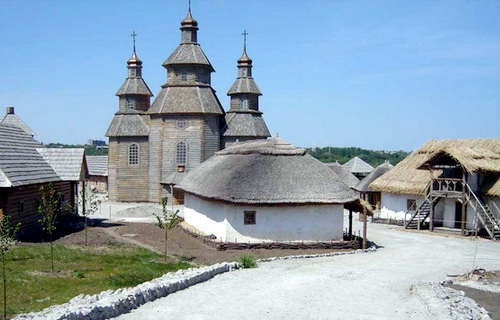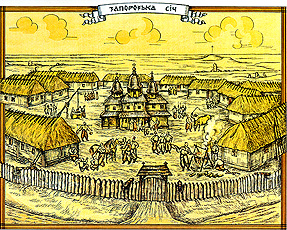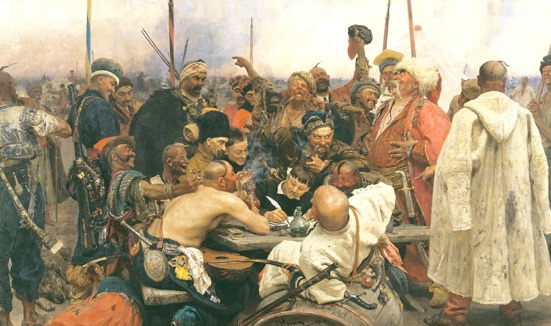2007


After Dzhankoy, we were back in the Ukrainian heartland, driving through the southern steppes along the course of the Dnipro River. Gone were the mountains, minarets, castles and strange place-names. We were back in land of wheat and sunflower fields, of small villages and blue and white churches.
Khortytsia:
We had left a little bit of time in our travel schedule to stop on the island of Khortytsia, voted in 2007 as one of the "Seven Wonders of Ukraine1." Sadly, the day was wet, rainy and gray, and it was definitely the off season. We found the island, which is in the Dnipro river just across for the city of Zaporizhia, without too much difficulty.
Zaporizhia takes its name from the nine Dnipro cataracts (literally, "behind the cataracts"), which were leveled in the 1930s, when the Dnipro Hydroelectric Station (see photo above) was constructed immediately upstream. Its importance in Ukrainian history stems from it being the center of a Cossack state in the 16th and 17th centuries.

Beginning in the 16th century, a Cossack stronghold on Khortytsia formed the core of the network of forts, which comprised the Zaporizhian Sich2. The Cossacks were free men, many having escaped from Russian and Polish serfdom, who banded together to protect their homeland against the raids of Crimean Tatars. Young Ukrainian men would leave home and go south into the steppes to Sich; here they could help protect their homes and families from a distance. The stronghold on Khortytsia was established by Hetman Vyshnevetsky3. After Russia annexed Crimea in 1774, the Cossacks no longer were of benefit to tsarist Russia, and became a threat instead. In 1775 empress Catherine ordered Sich destroyed, and it was4.
Nowadays, Khortysia is designated a national historical area. The landscape is rural, despite being just a bridge away from the city of Zaporizhia. There is a museum (the Zaporizhian Cossack Museum), a newly built reconstruction of the original sich (fort) and, in season, a Cossack horse show.

The museum building is modern-looking, nestled low in the landscape with dramatic views of the Dnieper Hydroelectric Station to the north. It also has no obvious posted entrance – we had to wander around it looking for a way in – and a leaky roof5.
The museum was built by the Soviets as a local historical museum, so it contains exhibits dating from throughout Ukrainian history: Stone Age statues, Scythian period artifacts, a model of the Pecheneg ambush which claimed the life of Svyatoslav (972),

and a panorama representing the WWII Battle for Zaporizhia:

Since independence, its focus has changed to that of Cossack history, so it now has extensive exhibits from that era, including weaponry, portraits, clothing, icons, dioramas,

and replicas of chaiky (Cossack long boats). We asked for and got a quick tour of the exhibits from the museum guide.
We didn't get a chance to visit the reconstructed Cossack fort, though; it was the off season, and the fort was being used for the filming of a new movie version of Taras Bulba." It was wet and muddy out as well. We did get to see it, perched on the shore, as we drove along the bridge from Khortytsia. I suspect I'll have to return one summer to see the island and the fort in all their glory.
Main UKRAINE Page
Main ROUTE Page
___________
-
1.In 2007, when all the hoopla was going on about choosing the Seven Wonders of the modern world, Ukraine decided to choose its own seven wonders. A contest was held in July of 2007: first, experts in Ukraine voted for the best historical and cultural sites, and the internet users voted for their favorites. The winners (in order) were:
Kyivo -Pechers'ka Lavra (Monastery of the Caves) in Kyiv
Sofiyivsky Park, in Uman, Cherkasy Oblast
Kamyanets-Podils'kyi Castle (moat and all) in Kamianets-Podilskyi, Khmelnytskyi Oblast
Khortytsia in Zaporizhia, Zaporizhia Oblast
Chersonesos in Sevastopol
Saint Sophia Cathedral in Kyiv
Khotyn Fortress in Khotyn, Chernivtsi Oblast -
2.The Zaporizhian Sich emerged as a defense by Ukrainians against the frequent and devastating raids of the Crimean Tatars. On their raids north, the Tatars captured hundreds of thousands of Ukrainians, Belarusians and Poles, and sold them into slavery. Such operations were called "the harvesting of steppe".
Not only did they fight the invading and raiding Tatars, but the Cossacks took the fight to the enemy, with raids on the Black Sea shores of the Ottoman Empire and Crimean Khanate, where they attacked and looted rich settlements, and also liberated their Slavic compatriots from slavery.

-
3.It was there on Khortytsia that the Cossacks would elect their hetmans. It was also there that they wrote the notorious reply to the Ottoman Sultan. (Look it up in Wikipedia.)

-
4.Some of the Cossack officers were incorporated into the Russian army, but most or the ordinary Cossacks were made state peasants and serfs. A group escaped to the Danube delta, and formed a new sich there.
-
5.A large section of the museum was closed off, and had buckets on the floor collecting the dripping rainwater. It was opened in 1983 as a museum of Zaporizhian history, and was Ukrianianized after independence. The building itself is a concrete Soviet monstrosity, although fairly unobtrusive compared to some.

Stylized map of Khortytsia
View of Dnipro Hydroelectric station from Khortytsia
Eastern Ukraine



